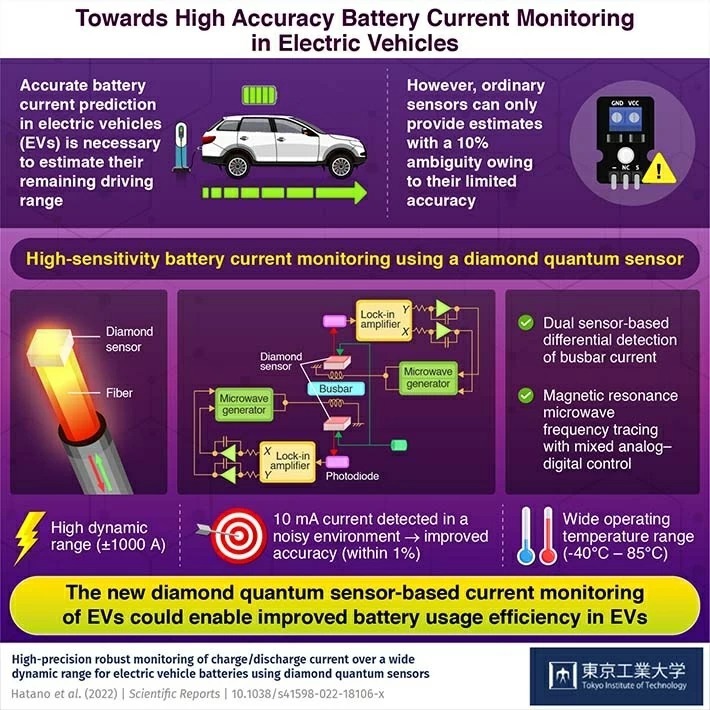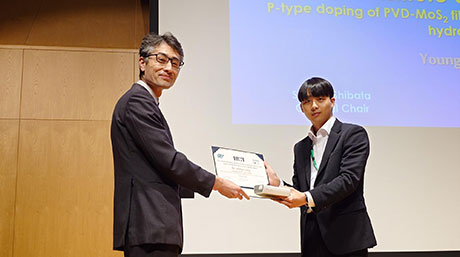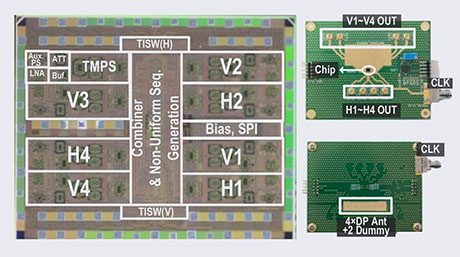Electrical and Electronic Engineering News
High-accuracy Electric Vehicle Battery Monitoring with Diamond Quantum Sensors for Driving Range Extension Towards Carbon Neutrality
The issue of battery usage inefficiency in electric vehicles resulting from an inaccurate battery charge measurement may finally get resolved, thanks to a diamond quantum sensor prototype developed in the MEXT Q-LEAP Flagship project with researchers from Tokyo Tech and Yazaki Corporation. The sensor can measure currents in a wide range as well as detect milliampere-level currents in a noisy environment, improving the detection accuracy from 10% to within 1%.

The popularity of electric vehicles (EVs) as an environmentally friendly alternative to conventional gasoline vehicles has been on the rise. This has led to research efforts directed towards developing high-efficiency EV batteries. But, a major inefficiency in EVs results from inaccurate estimations of the battery charge. The charge state of an EV battery is measured based on the current output of the battery. This provides an estimate of the remaining driving range of the vehicles.
Typically, the battery currents in EVs can reach hundreds of amperes. However, commercial sensors that can detect such currents cannot measure small changes in the current at milliampere levels. This leads to an ambiguity of around 10% in the battery charge estimation. What this means is that the driving range of EVs could be extended by 10%. This, in turn, would reduce inefficient battery usage.
Fortunately, a team of researchers from Japan, led by Professor Mutsuko Hatano from Tokyo Institute of Technology (Tokyo Tech), has now come up with a solution. In their study published in Scientific Reports![]() , the team has reported a diamond quantum sensor-based detection technique that can estimate the battery charge within 1% accuracy while measuring high currents typical of EVs.
, the team has reported a diamond quantum sensor-based detection technique that can estimate the battery charge within 1% accuracy while measuring high currents typical of EVs.
"We developed diamond sensors that are sensitive to milliampere currents and compact enough to be implemented in automobiles. Furthermore, we measured currents in a wide range as well as detected milliampere-level currents in a noisy environment," explains Prof. Hatano.
In their work, the team made a prototype sensor using two diamond quantum sensors that were placed on either side of the busbar (electrical junction for incoming and outgoing currents) in the car. They then used a technique called "differential detection" to eliminate the common noise detected by both the sensors and retain only the actual signal. This, in turn, enabled them to detect a small current of 10 mA amid background environmental noise.
Next, the team used a mixed analog-digital control of the frequencies generated by two microwave generators to trace the magnetic resonance frequencies of the quantum sensor over a bandwidth of 1 gigahertz. This allowed for a large dynamic range (ratio of largest to smallest current detected) of ±1000 A. Moreover, a wide operating temperature range of −40 to +85°C was confirmed to cover general vehicular applications.
Finally, the team tested this prototype for Worldwide Harmonized Light Vehicles Test Cycle (WLTC) driving, a standard test for energy consumption in EVs. The sensor accurately traced the charge/discharge current from -50 A to 130 A and demonstrated the battery charge estimation accuracy within 1%.
What are the implications of these findings? Prof. Hatano remarks, "Increasing battery usage efficiency by 10% would reduce battery weight by 10%, which will reduce 3.5% running energy and 5% production energy of 20 million new EVs in 2030 WW. This, in turn, corresponds to a 0.2% reduction in CO2 emissions in 2030 WW transportation field."
We certainly hope this breakthrough takes us one step closer to a carbon neutral society!
- Reference
| Authors : | Yuji Hatano1, Jaewon Shin2, Junya Tanigawa2, Yuta Shigenobu1, Akimichi Nakazono2, Takeharu Sekiguchi1, Shinobu Onada3, Takeshi Ohshima3, Keigo Arai1, Takayuki Iwasaki1, and Mutsuko Hatano1,3,* |
|---|---|
| Title of original paper : | High-Precision robust monitoring of charge/discharge current over a wide dynamic range for electric vehicle batteries using diamond quantum sensors |
| Journal : | Scientific Reports |
| DOI : | 10.1038/s41598-022-18106-x |
| Affiliations : | 1Department of Electrical and Electronic Engineering, School of Engineering, Tokyo Institute of Technology 2Yazaki Corporation 3National Institutes for Quantum Science and Technology |
|
* Corresponding author's email: hatano.m.ab@m.titech.ac.jp |
|
- Measuring Currents in the Heart at Millimeter Resolution with a Diamond Quantum Sensor | Tokyo Tech News
- How Flawed Diamonds "Lead" to Flawless Quantum Networks | Tokyo Tech News
- Artificially introduced atomic-level sensors enable measurements of the electric field within a working semiconductor device | Tokyo Tech News
- New diamond structures produce bright luminescence for quantum cryotography and biomarkers applications | Tokyo Tech News
- Quantum science and technology | Research Stories | Research
- Mutsuko Hatano - Diamonds as the ultimate semiconductors | Research Stories | Research
- Six Tokyo Tech faculty members receive FY2019 MEXT Commendation | Tokyo Tech News
- Associate Professor Takayuki Iwasaki receive FY2019 MEXT Commendation|Electrical and Electronic Engineering News
- Hatano & Iwasaki Lab
- Mutsuko Hatano | Researcher Finder - Tokyo Tech STAR Search
- Takayuki Iwasaki | Researcher Finder - Tokyo Tech STAR Search
- Energy Science and Engineering Graduate Major|Education|Department of Electrical and Electronic Engineering, School of Engineering
- Electrical and Electronic Engineering Graduate Major|Education|Department of Electrical and Electronic Engineering, School of Engineering
- Electrical and Electronic Engineering Undergraduate Major|Education|Department of Electrical and Electronic Engineering, School of Engineering
- Yazaki Research and Technology Center
- Latest Research News
School of Engineering
—Creating New Industries and Advancing Civilization—
Information on School of Engineering inaugurated in April 2016
Further Information
Professor Mutsuko Hatano
School of Engineering, Tokyo Institute of Technology






